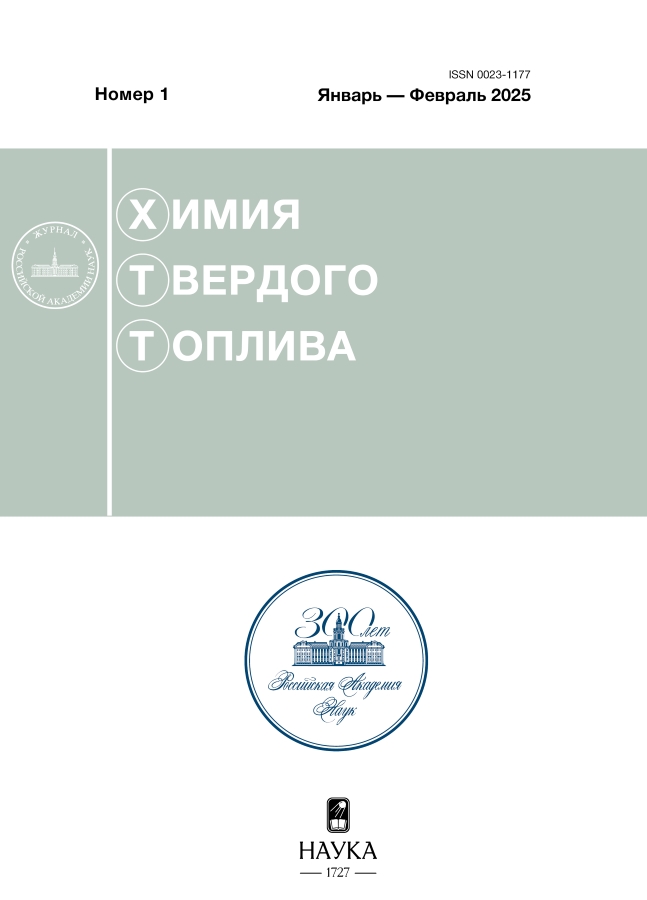Resins transformation in the cracking of high sulfur vaccum residue
- Autores: Goncharov A.V.1, Krivtsov E.B.1
-
Afiliações:
- Institute of Petroleum Chemistry of Siberian Branch of the Russian Academy of Sciences
- Edição: Nº 1 (2025)
- Páginas: 75-81
- Seção: Articles
- URL: https://jdigitaldiagnostics.com/0023-1177/article/view/684065
- DOI: https://doi.org/10.31857/S0023117725010103
- EDN: https://elibrary.ru/KTOAFS
- ID: 684065
Citar
Texto integral
Resumo
The results of the study of resins isolated from liquid cracking products of sulfuric vacuum residue from Omsk refinery are presented. Thermal treatment was carried out at 500 °C and duration of 15, 30, 45 and 60 minutes. It was found that with increasing duration of vacuum residue cracking there is an increase in coke yield due to condensation of resins into asphaltenes and further into coke. Using the data of 1H-NMR spectroscopy, elemental composition and results of molecular weight measurement the changes of structural-group parameters of resins in the process of cracking were established. The averaged resin molecules become more condensed, characterized by an increased content of aromatic fragments, a decrease in the number of naphthenic fragments and the number of aliphatic substituents. The totality of data on changes in the composition of cracking products, together with the analysis of sulfur distribution in the composition of products, indicates a significant contribution of sulfur-containing structural fragments of resins to the accumulation of thiophene derivatives. It is shown that cracking of resins is accompanied by formation of a wide range of low-molecular-weight sulfur-containing compounds that are incorporated into oils.
Palavras-chave
Texto integral
Sobre autores
A. Goncharov
Institute of Petroleum Chemistry of Siberian Branch of the Russian Academy of Sciences
Autor responsável pela correspondência
Email: mad111-2011@mail.ru
Rússia, Tomsk
E. Krivtsov
Institute of Petroleum Chemistry of Siberian Branch of the Russian Academy of Sciences
Email: john@ipc.tsc.ru
Rússia, Tomsk
Bibliografia
- Sawarkar A.N. // Petroleum Science and Technology. 2019. V. 37. №. 9. P. 1090. https://doi.org/10.1080/10916466.2019.1575875.
- Prajapati R., Kohli K., Maity S.K., Garg M.O. // Fuel. 2017. V. 203. P. 514. https://doi.org/10.1016/j.fuel.2017.04.126.
- Felix G., Tirado A., Varfolomeev M.A., Al-muntaser A., Suwaid M., Yuan Ch., Ancheyata J. // Geoenergy Science and Engineering. 2023. V. 230. P.212242. https://doi.org/10.1016/j.geoen.2023.212242.
- Певнева Г.С., Воронецкая Н.Г., Гончаров А.В., Корнеев Д.С. // ХТТ. 2024. № 2. С. 31. https://doi.org/10.31857/S0023117724020068.
- Kheirolahi S., BinDanbag M., Bagherzadeh H., Abbasi Z. // Fuel. 2024. V. 371. P. 131884. https://doi.org/10.1016/j.fuel.2024.131884.
- Pagan Pagan N.M., Zhang Z., Nguyen T.V., Marciel A.B., Biswal S.B. // Chemical Reviews. 2022. V. 122. P.7205. https://doi.org/10.1021/acs.chemrev.1c00897.
- Fakher S., Ahdaya M., Elturki., Imqam A. // Journal of Petroleum Exploration and Production Technology. 2020. V. 10. P. 1183.
- Головко А.К., Гринько А.А. // Нефтехимия. 2018. Т. 58. № 4. С. 391. https://doi.org/10.1134/S002824211804008X. [Petroleum Chemistry, 2019, vol. 58, no. 8, p. 599. https://doi.org/10.1134/S0965544118080078].
- Primerano K., Mirwald J., Hofko B. // Fuel. 2024. V. 368. P. 131616. https://doi.org/10.1016/j.fuel.2024.131616.
- Goncharov A.V., Krivtsov E.B., Sviridenko N.N., Golovko A.K. // IOP Conf. Ser.: Mater. Sci. 2019. P. 012022. https://doi.org/10.1088/1757-899X/597/1/012022.
Arquivos suplementares











